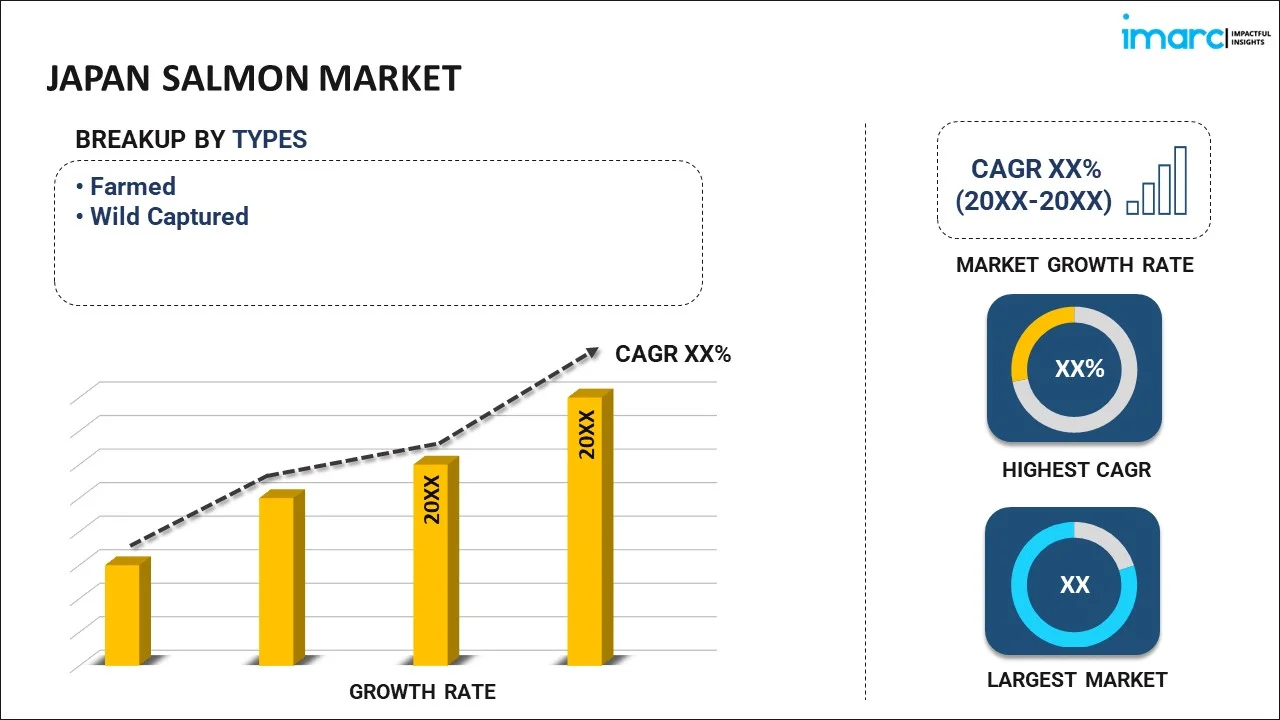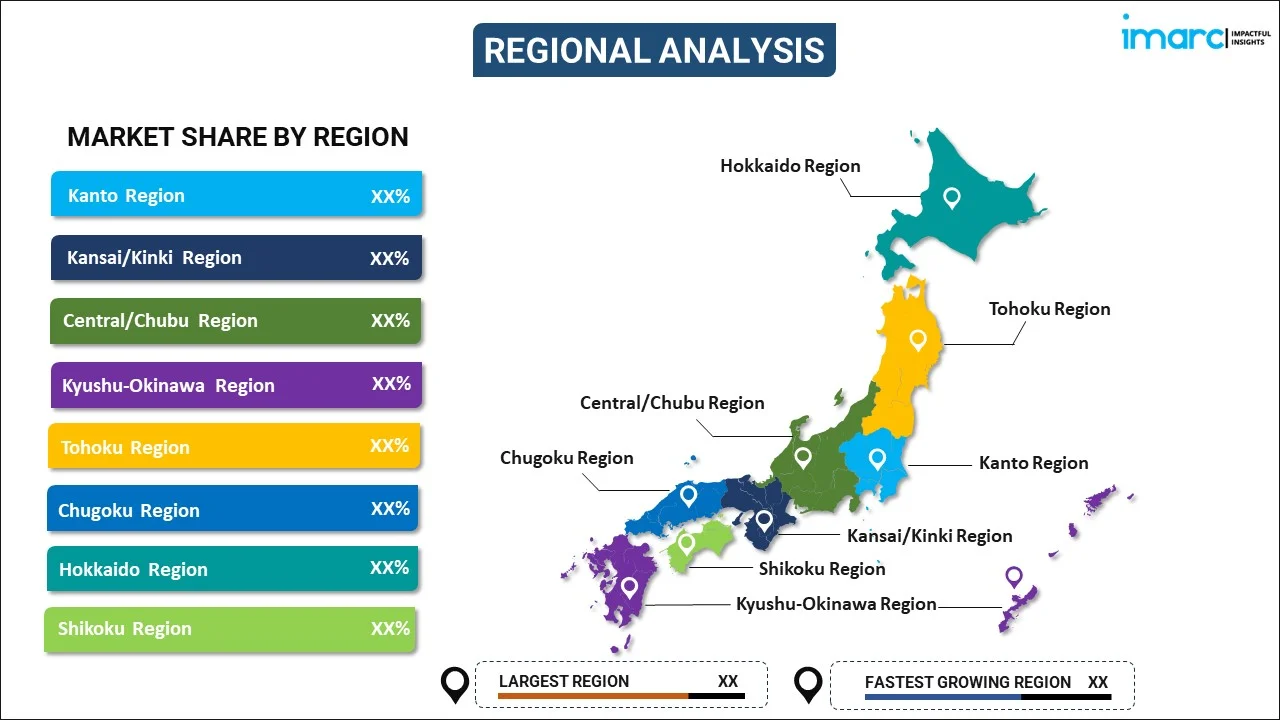
Japan Salmon Market Report by Type (Farmed, Wild Captured), Specie (Atlantic, Pink, Chum/Dog, Coho, Sockeye, and Others), Product Type (Frozen, Fresh, Canned, and Others), Distribution Channel (Foodservice, Retail), and Region 2025-2033
Market Overview:
Japan salmon market size reached 70.4 Thousand Tons in 2024. Looking forward, IMARC Group expects the market to reach 96.8 Thousand Tons by 2033, exhibiting a growth rate (CAGR) of 3.3% during 2025-2033. The health benefits offered by the product, culinary versatility of salmon, increasing western influence, promotion of Japanese seafood abroad, adoption of sustainable farming practices, increased affordability, growing health-conscious population, and cultural significance of salmon represent some of the key factors driving the market.
|
Report Attribute
|
Key Statistics
|
|---|---|
|
Base Year
|
2024
|
|
Forecast Years
|
2025-2033
|
|
Historical Years
|
2019-2024
|
|
Market Size in 2024
|
70.4 Thousand Tons |
|
Market Forecast in 2033
|
96.8 Thousand Tons |
| Market Growth Rate 2025-2033 | 3.3% |
Salmon is a type of fish known for its distinctive pink or orange flesh and delicious taste. It is a popular seafood choice in many parts of the world, including North America, Europe, and Asia. Salmon is found in both freshwater and saltwater environments, and it is known for its remarkable life cycle. These fish are born in freshwater rivers and streams, where they hatch from eggs laid by adult salmon. They then spend a portion of their lives in freshwater before migrating to the ocean, where they grow and mature. When it's time to reproduce, adult salmon return to the same freshwater streams where they were born, a remarkable navigational feat. Salmon is renowned for its flavor and nutritional value. It is an excellent source of high-quality protein and essential vitamins and minerals. It is also rich in omega-3 fatty acids, which are beneficial for heart health and reduce the risk of certain diseases.
Japan Salmon Market Trends:
Salmon is widely recognized for its health benefits. It is rich in omega-3 fatty acids, which are known to promote heart health, reduce the risk of cardiovascular diseases, and improve cognitive function. As health-conscious consumers seek nutritious food options, the reputation of salmon as a healthy choice has boosted its popularity in Japan. Additionally, the versatility of salmon in the food industry makes it a favorite among Japanese consumers. It can be prepared in various ways, including sashimi, sushi, grilled, or as part of traditional dishes like salmon teriyaki. Its adaptability to different cooking styles has made it a staple in Japanese cuisine. Other than this, the food culture of Japan has been influenced by Western cuisine, due to which, dishes like salmon sushi rolls and salmon burgers have gained popularity, appealing to a broader range of tastes. Besides this, the adoption of sustainable salmon farming practices has ensured a consistent supply of high-quality salmon in the Japanese market. These practices prioritize environmental responsibility and have contributed to consumer confidence in the quality of the product. In line with this, as production and distribution have improved, salmon has become more affordable for a wider range of consumers. This accessibility has driven up consumption levels within Japan. Furthermore, the Japanese government and seafood industry have actively promoted Japanese seafood, including salmon, in international markets. This has increased awareness about Japanese salmon products and led to higher demand both domestically and globally. Moreover, salmon also holds cultural significance in Japan, with various regions celebrating annual salmon festivals and rituals. These factors are expected to create a favorable market outlook in the upcoming years.
Japan Salmon Market Segmentation:
IMARC Group provides an analysis of the key trends in each segment of the market, along with forecasts at the country level for 2025-2033. Our report has categorized the market based on type, species, product type, and distribution channel.
Type Insights:

- Farmed
- Wild Captured
The report has provided a detailed breakup and analysis of the market based on the type. This includes farmed and wild captured.
Species Insights:
- Atlantic
- Pink
- Chum/Dog
- Coho
- Sockeye
- Others
A detailed breakup and analysis of the market based on the species have also been provided in the report. This includes atlantic, pink, chum/dog, coho, sockeye, and others.
Product Type Insights:
- Frozen
- Fresh
- Canned
- Others
The report has provided a detailed breakup and analysis of the market based on the product type. This includes frozen, fresh, canned, and others.
Distribution Channel Insights:
- Foodservice
- Retail
A detailed breakup and analysis of the market based on the distribution channel have also been provided in the report. This includes foodservice and retail.
Regional Insights:

- Kanto Region
- Kansai/Kinki Region
- Central/ Chubu Region
- Kyushu-Okinawa Region
- Tohoku Region
- Chugoku Region
- Hokkaido Region
- Shikoku Region
The report has also provided a comprehensive analysis of all the major regional markets, which include Kanto Region, Kansai/Kinki Region, Central/ Chubu Region, Kyushu-Okinawa Region, Tohoku Region, Chugoku Region, Hokkaido Region, and Shikoku Region.
Competitive Landscape:
The market research report has also provided a comprehensive analysis of the competitive landscape. Competitive analysis such as market structure, key player positioning, top winning strategies, competitive dashboard, and company evaluation quadrant has been covered in the report. Also, detailed profiles of all major companies have been provided.
Japan Salmon Market Report Coverage:
| Report Features | Details |
|---|---|
| Base Year of the Analysis | 2024 |
| Historical Period | 2019-2024 |
| Forecast Period | 2025-2033 |
| Units | 000 Tons |
| Scope of the Report | Exploration of Historical and Forecast Trends, Industry Catalysts and Challenges, Segment-Wise Historical and Predictive Market Assessment:
|
| Types Covered | Farmed, Wild Captured |
| Species Covered | Atlantic, Pink, Chum/Dog, Coho, Sockeye, Others |
| Product Types Covered | Frozen, Fresh, Canned, Others |
| Distribution Channels Covered | Foodservice, Retail |
| Regions Covered | Kanto Region, Kansai/Kinki Region, Central/ Chubu Region, Kyushu-Okinawa Region, Tohoku Region, Chugoku Region, Hokkaido Region, Shikoku Region |
| Customization Scope | 10% Free Customization |
| Post-Sale Analyst Support | 10-12 Weeks |
| Delivery Format | PDF and Excel through Email (We can also provide the editable version of the report in PPT/Word format on special request) |
Key Questions Answered in This Report:
- How has the Japan salmon market performed so far and how will it perform in the coming years?
- What has been the impact of COVID-19 on the Japan salmon market?
- What is the breakup of the Japan salmon market on the basis of type?
- What is the breakup of the Japan salmon market on the basis of species?
- What is the breakup of the Japan salmon market on the basis of product type?
- What is the breakup of the Japan salmon market on the basis of distribution channel?
- What are the various stages in the value chain of the Japan salmon market?
- What are the key driving factors and challenges in the Japan salmon?
- What is the structure of the Japan salmon market and who are the key players?
- What is the degree of competition in the Japan salmon market?
Key Benefits for Stakeholders:
- IMARC’s industry report offers a comprehensive quantitative analysis of various market segments, historical and current market trends, market forecasts, and dynamics of the Japan salmon market from 2019-2033.
- The research report provides the latest information on the market drivers, challenges, and opportunities in the Japan salmon market.
- Porter's five forces analysis assist stakeholders in assessing the impact of new entrants, competitive rivalry, supplier power, buyer power, and the threat of substitution. It helps stakeholders to analyze the level of competition within the Japan salmon industry and its attractiveness.
- Competitive landscape allows stakeholders to understand their competitive environment and provides an insight into the current positions of key players in the market.
Need more help?
- Speak to our experienced analysts for insights on the current market scenarios.
- Include additional segments and countries to customize the report as per your requirement.
- Gain an unparalleled competitive advantage in your domain by understanding how to utilize the report and positively impacting your operations and revenue.
- For further assistance, please connect with our analysts.
 Inquire Before Buying
Inquire Before Buying
 Speak to an Analyst
Speak to an Analyst
 Request Brochure
Request Brochure
 Request Customization
Request Customization




.webp)




.webp)












